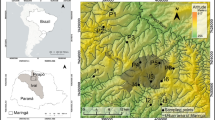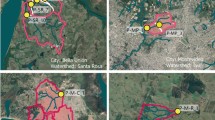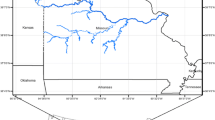Abstract
This study was undertaken to analyze the quantitative impact ofa municipal wastewater treatment operation on the long-term waterquality changes in a tributary of the Han-river, Korea from 1994to 1999. Changes of land use pattern in the study watershed arequantitatively analyzed on the basis of land use maps that werecreated by classifying Landsat TM images acquired in April 1994and March 1999. During this period, the average increase of landuse area in terms of residence, cultivation, and barren was 5.89,0.13, and 0.12%, respectively, and the corresponding decrease in water and forest area was 0.21 and 0.16%. The annual averagereductions of BOD, T-N, and T-P by the municipal wastewatertreatment operation were about 89, 11 and 27%, respectively.Spatial analysis of the pollution discharge from watershed wasundertaken using a geographic information system (GIS) based model. A clear reciprocal relationship was found between the basin-wide self-purification coefficient and the watershed form ratio excepting a catchment area with water drain facilities. Due to land use changes over the five year studyperiod, water quality change in terms of BOD, T-N, and T-P were(+)1.04 mg l-1 (corresponding to a 13.7% increase ofpollution), (+)0.58 mg l-1 (10.0% increase), and (–)0.01 mg l-1 (1.6% decrease). On the other hand, the effect of water quality restoration assessed by outward appearance duringthe same period was about 67.6, 39, and 36.5%, respectively.Consequently, it is understood that total stream water qualityrecovery in terms of BOD, T-N, and T-P were 81.3, 49.0, and38.1% respectively, and that this included a negativecontribution resulting from increased land use and a positivecontribution due to the wastewater treatment operation atInchon.
Similar content being viewed by others
References
Bishop, C. M.: 1995, Neural Networks for Pattern Recognition, Oxford, U.K.
Brown, L. C. and Barnwell, T. O.: 1987, The Enhanced Stream Water Quality Models QUAL2E and QUAL2E-UNCAS: Documentation and User Manual, EPA-600/3–87/007.
Carlo, G. and Paolo, R.: 1999, ‘Agricultural land use changes and water quality: a case study in the watershed of the lagoon of Venice’, Water Sci. Technol. 39(3), 135–148.
Dayawansa, N. D. K.: 1997, ‘Identification of Non-point Source Pollution Risk using GIS and Remote Sensing Techniques’, Proceedings of the 18 Asian Conference on Remote Sensing, ACRS, Kuala Lumpur, Malaysia, 191–196.
Ersoy, O. K. and Hong, D.: 1990, ‘Parallel, self-organizing, hierarchical neural networks’, IEEE Trans. Neural Networks 2(2), 167–178.
Ha, S. R., Jung, D. I. and Yoon, C. H.: 1998, ‘A renovated model for spatial analysis of pollutant runoff loads in agricultural watershed’, Water Sci. and Technol. 38(10), 207–214.
Ha, S. R., Park, D. H. and Park, S. Y.: 2000, ‘Optimal Classification Process for KOMPSAT-EOC Using RBF-NN and Image Fusion’, Proceedings of the 2000 International Symposium on Remote Sensing, Kyongju, Korea, 422–427.
Author information
Authors and Affiliations
Corresponding author
Rights and permissions
About this article
Cite this article
Ha, SR., Bae, MS. Effects of Land Use and Municipal Wastewater Treatment Changes on Stream Water Quality. Environ Monit Assess 70, 135–151 (2001). https://doi.org/10.1023/A:1010649705723
Issue Date:
DOI: https://doi.org/10.1023/A:1010649705723




